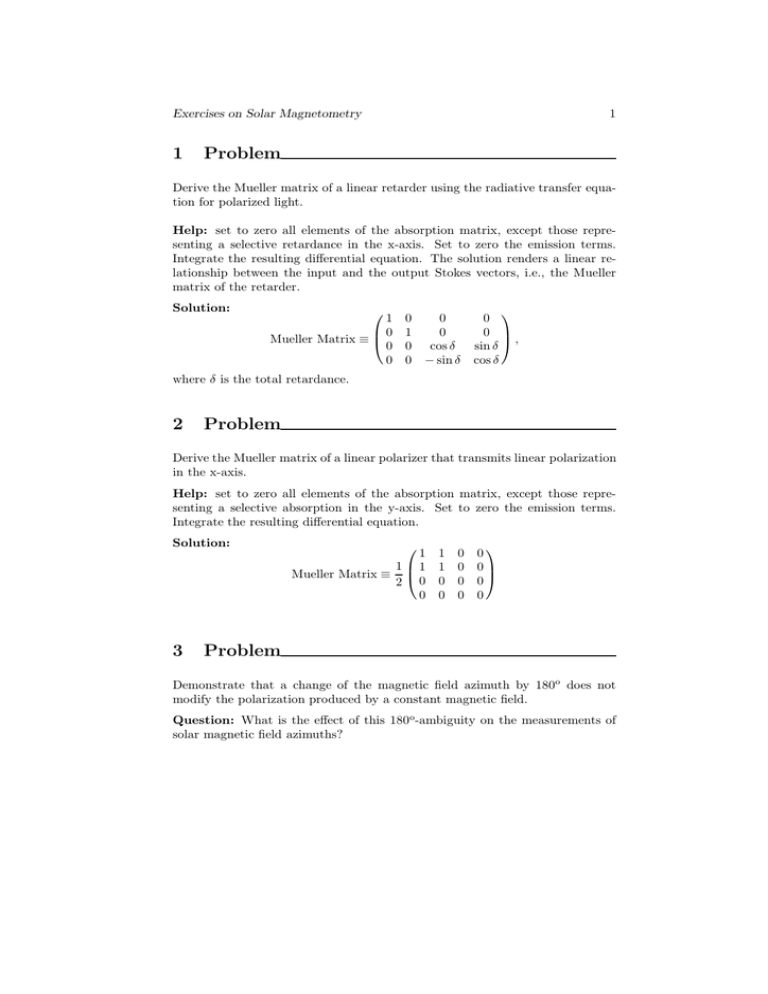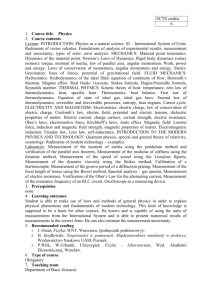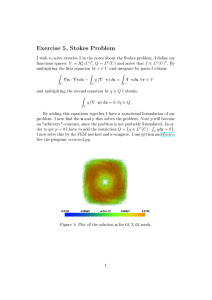1 Problem
advertisement

1 Exercises on Solar Magnetometry 1 Problem Derive the Mueller matrix of a linear retarder using the radiative transfer equation for polarized light. Help: set to zero all elements of the absorption matrix, except those representing a selective retardance in the x-axis. Set to zero the emission terms. Integrate the resulting differential equation. The solution renders a linear relationship between the input and the output Stokes vectors, i.e., the Mueller matrix of the retarder. Solution: 1 0 Mueller Matrix ≡ 0 0 0 1 0 0 0 0 cos δ − sin δ 0 0 , sin δ cos δ where δ is the total retardance. 2 Problem Derive the Mueller matrix of a linear polarizer that transmits linear polarization in the x-axis. Help: set to zero all elements of the absorption matrix, except those representing a selective absorption in the y-axis. Set to zero the emission terms. Integrate the resulting differential equation. Solution: 1 1 1 Mueller Matrix ≡ 2 0 0 3 1 1 0 0 0 0 0 0 0 0 0 0 Problem Demonstrate that a change of the magnetic field azimuth by 180o does not modify the polarization produced by a constant magnetic field. Question: What is the effect of this 180o-ambiguity on the measurements of solar magnetic field azimuths? 2 Exercises on Solar Magnetometry 4 Problem Show that in LTE and if the velocity is zero, the Stokes I, Q, U profiles are symmetric whereas the Stokes V profile is anti-symmetric, I(λ) = I(−λ), Q(λ) = Q(−λ), U (λ) = U (−λ), V (λ) = −V (−λ). The symbol λ stands for the wavelength referred to the central wavelength of the transition. Help: All Zeeman patterns are symmetric, i.e., for each red-shifted σ+ component there is a blue-shifted σ− with the same amplitude. Similarly, each redshifted π-component is paired off with a blue-shifted π-component. Keep also in mind that the absorption profile of each component is symmetric, whereas the retardance profile is anti-symmetric. 5 Problem The observed Stokes V profiles are never anti-symmetric, implying the existence of spatially unresolved structures in the resolution elements. The resolution elements of present solar observations are much thinner in the direction along the line-of-sight (some 100 km) than in the directions perpendicular to the line-of-sight (some 725 km, for 1" resolution). Demonstrate that if an observed Stokes V profile shows net-circular polarization (NCP), the unresolved structure is smaller than the smallest dimension of the resolution element (smaller than, say, 100 km). The NCP is defined as the mean Stokes V averaged over the line profile, N CP = Z λf V (λ) dλ. λi The absorption produced by the spectral line is assumed to be zero outside the range limited by λi and λf . Help: Work out the NCP produced by unresolved velocity sub-structure which varies across the line-of-sight but is constant along the line-of-sight. 3 Exercises on Solar Magnetometry 6 Problem In order to explain the Broad-Band Circular polarization observed in Sunspots, Makita (1986, Solar Phys. 106, 269) proposed the generation of circular polarization by spectral lines formed in a transverse magnetic field (i.e., a magnetic field perpendicular to the line-of-sight). Is it possible or should Makita attend a school on solar magnetometry before proposing such things? Help: Makita does not need to attend the school on magnetometry. 7 Problem Demonstrate that there is no instrumental polarization (IP) in the primary focus of a telescope. More precisely, the telescope does not produce IP on the optical axis at that primary focus. Procedure: First, write down the Jones matrix corresponding to the reflection on a flat mirror. Be careful with the reference systems in which it is expressed. Then divide the entrance aperture of the telescope into small sub-apertures. The Jones matrix of each one of these sub-apertures is the Jones matrix of a flat mirror. Add up the contributions off all sub-apertures to compute the net effect produced by the primary mirror of the telescope. Help: If an optical device is rotated by an angle α, the Jones matrix of the rotated device m(α) is just m(α) = R(−α) m(0) R(α) with R(α) cos α sin α − sin α cos α . The new Jones matrix is expressed in the same reference systems in which the original Jones matrix m(0) was expressed. Questions: 1. What is the IP in a Cassegrain focus? 2. What is the IP in a Coude focus? Does is vary with time? 3. Why was the average carried out using Jones matrices rather than Mueller matrices? 4. What happens if one measures off the optical axis? 4 Exercises on Solar Magnetometry 8 Problem Calibration of a real magnetogram. The term calibrate a magnetogram means transforming the observed degree of circular polarization into magnetic flux densities along the line-of-sight. Use the so-called magnetograph equation, V (λ) = −k Bz λ20 gef f dI(λ) , dλ (1) which provide the relationship between the circular polarization V at each wavelength λ, and the magnetic flux density along the line-of-sight Bz . The symbols gef f and λ0 stand for the effective Lande factor and the central wavelength of the transition, respectively. When I and V have the same units, the calibration constant is k = 4.67 × 10−13 Å−1 G−1 . (2) Needs: IDL. The data are stored as an IDL saveset. It is called mag problem.save and it contains the following variables magneto: raw magnetogram, i.e., an image made out of Stokes V signals. stokesi: Stokes I profile containing the spectral line used to produce the magnetogram. wave: wavelength of stokesi, in Å and refereed to 6302.5 Å. wave0: central wavelength of the line used to produce the magnetogram. filter wave: central wavelength of the color filter used to obtain the magnetogram (in Å and referred to wave0). filter width: band-pass of the color filter (in Å). Information: The magnetogram has been taken in the blue flank of the Fe i line at 6302.5 Å, which has an effective Lande factor of 2.5. The color filter has a box-like shape, i.e., it is zero within the band-pass and zero elsewhere. The pixel size of the magnetogram is 280 km × 280 km. Surface area of the Sun: 6.09 × 1022 cm2 . Questions: 1. What is the calibration constant of the magnetogram, i.e., the constant that transforms the degree of polarization into G units. 2. Compute the magnetic flux of the full observed region. 3. Compute the unsigned magnetic flux density of full observed region. Exercises on Solar Magnetometry 5 4. If the full sun were covered by magnetic fields like the ones in this magnetogram, what would be the unsigned flux that they carry? Active regions during the solar maximum carry some 8 × 1023 Mx (1 Mx=1G cm2 ). 9 Problem Determine the magnetic field strength in the umbra of a sunspot using a MilneEddington inversion. Needs: IDL. The data are stored as an IDL saveset named sunspot 6302.save. It contains a set of Stokes profiles of Fe i 6303.5 Å observed in an umbra, si0: Stokes I profile, referred to the continuum intensity of the quiet Sun. sq0: Stokes Q profile. su0: Stokes U profile. sv0: Stokes V profile. wave0: wavelength in Å and refereed to 6302.5 Å. Procedure: Use the IDL routine plot me.pro to synthesize the Stokes profiles of Fe i 6302.5 Å. By trial and error, vary the free parameters of this line up to a point where the observed polarization is reproduced. Help: You may need to neglect Stokes I when fitting the polarization. Why? Information: The effective Lande factor of Fe i 6302.5 Å is 2.5. Questions: 1. What are the magnetic field strength, inclination and azimuth of this umbra? Check the 180o ambiguity. 2. What is the macroscopic velocity? 3. Have you used Stokes I when fitting the Stokes profiles? If the answer is no, explain why. 6 Exercises on Solar Magnetometry 10 Problem The so-called line-ratio-method (LRM) was introduced by Stenflo (1973, Solar Phys., 32, 41) to show that the magnetic field strengths in plage regions are strong (kG), despite the fact that magnetograph observations find them to be weak (say, 100 G). The LRM models the ratio between the magnetograph signals observed in two spectral lines that are identical in unmagnetized atmospheres but whose Zeeman splitting is very different (Fe i 5250 Å, gef f = 3, and Fe i 5247 Å, gef f = 2). Should the magnetic field were weak, the ratio between the magnetograph signals observed in these two lines would be given by the ratio of effective Landé factors, i.e., VF eI 5250 (λ)/VF eI 5247 (λ) = 1.5 However, plage observations show VF eI 5250 (λ)/VF eI 5247 (λ) ≃ 1.1 when λ ≃ 50 mÅ (λ: wavelength refereed to the line center). Use the LRM to show that this observational fact implies kG field strengths in plage regions. Explain why magnetographs render apparent magnetic fields that are much weaker than the intrinsic ones. Procedure: Use the solutions of the radiative transfer equation for polarized light in a Milne-Eddington atmosphere with longitudinal magnetic field. They yield Stokes V profiles given by V (λ) ∝ 1 1 − 1 + η0 f (λ + ∆λB ) 1 + η0 f (λ − ∆λB ) Keep in mind that ∆λBF eI 5250 = 38.6 mÅ B , 1000 G ∆λBF eI 5247 = 25.7 mÅ B . 1000 G and Compute the ratio VF eI 5250 /VF eI 5247 at λ = 50 mÅ for a range of magnetic field strengths. Choose the one that renders the observed ratio. For these lines, the line-to-continuum absorption coefficient ratio η0 is some 2, whereas the absorption profile f (λ) can be a Gaussian function with full-width-halfmaximum 90 mÅ and area equals one. J. Sánchez Almeida,. Oslo, June 2007.



